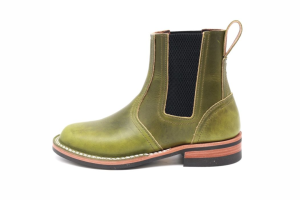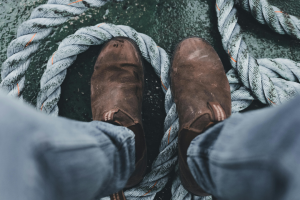How To Wash Leather Boots: Step-By-Step Cleaning Guide

Key Takeaways:
- Full-Grain Leather Requires Gentle Care: To protect their quality and appearance over time, full-grain leather boots benefit from specific cleaning and conditioning products.
- Proper Tools Are Essential: Use soft-bristle brushes, leather cleaners, and conditioners to clean your boots effectively and safely.
- Regular Maintenance Preserves Longevity: Establishing a cleaning, conditioning, and proper storage routine ensures your boots remain durable and look great for years.
It’s no secret.
Keeping your leather boots looking their best comes from regular care and cleaning. These simple habits preserve the durability and timeless appearance of full-grain leather boots, ensuring they last for years.
At Nicks Boots, every pair represents unmatched craftsmanship. Premium materials are used to create boots that are as functional as stylish. When cared for properly, they become a lasting investment, built for comfort and longevity.
In this guide, we’ll walk you through a simple yet thorough process to clean your leather boots without compromising their quality. With the proper steps, you can maintain their durability, extend their lifespan, and keep them looking as sharp as the day you bought them.
Why Proper Cleaning Matters For Leather Boots
Leather boots are an investment in style, comfort, and functionality. However, without proper cleaning, dirt and debris can settle into the leather’s pores, causing premature wear and compromising the material’s strength. Moisture, if left unchecked, can also lead to mold and damage that weakens the structural integrity of the boots over time.
Regular cleaning goes beyond aesthetics — it helps preserve the natural oils in full-grain leather, keeping it supple and resistant to cracking. This simple care routine protects the craftsmanship and ensures your boots remain breathable, durable, and ready for any occasion. Proper maintenance extends your boots' life and safeguards your investment's value.


Tools And Materials Needed To Wash Leather Boots
Proper tools and materials are essential for safely cleaning your full-grain leather boots. Using the right items ensures the leather remains undamaged while maintaining its appearance and durability. Below is a breakdown of each tool you’ll need and its role in the cleaning process:
- Soft-Bristle Brush Or Cloth: A soft-bristle brush or microfiber cloth is ideal for removing surface dirt and debris. These tools are gentle enough to avoid scratching or scuffing the leather but are effective in reaching crevices. Start lightly brushing the boots to eliminate loose dirt before applying any cleaner.
- Leather Cleaner Or Saddle Soap: Leather cleaner or saddle soap is formulated specifically for cleaning full-grain leather without stripping its natural oils. These products help lift dirt and stains from the surface while nourishing the material. Always use a cleaner designed for leather to prevent chemical damage or dryness.
- Clean Water: Lukewarm water is crucial for rinsing dirt and soap residue without shocking the leather fibers. Cold water can stiffen the leather, while hot water might dry it too quickly. Combine water with a leather cleaner for the washing process to ensure even cleaning.
- Leather Conditioner: A quality leather conditioner replenishes the natural oils that keep your boots soft and resistant to cracking. It also enhances the leather's natural sheen, restoring its appearance after cleaning. Apply conditioner evenly to maintain a supple and durable finish.
- Microfiber Towel: A microfiber towel is perfect for gently drying the boots after cleaning. Its soft texture absorbs moisture efficiently without causing abrasions. Use it to pat the leather dry before leaving the boots in a well-ventilated area to air-dry completely.
Step 1: Preparing Your Boots For Cleaning
Before beginning the cleaning process, preparing your boots properly is essential. This step ensures the cleaning is effective while protecting the integrity of the full-grain leather. Careful preparation also sets the foundation for a deeper clean, allowing you to focus on preserving the craftsmanship of your boots.
Remove The Laces
Removing the laces prevents them from soaking up water or cleaning solutions that could weaken or discolor them. This step also exposes the boots' tongue and eyelets, allowing you to clean hard-to-reach areas thoroughly. If the laces are dirty, they can be washed separately with mild soap and water.
Inspect The Boots
Scrutinize your boots for stains, scuffs, or areas of heavy dirt buildup. This helps you identify spots requiring extra attention during the cleaning process. By addressing problem areas first, you can avoid uneven cleaning or spreading stains further.
Brush Off Loose Dirt
Remove surface dirt and debris using a soft-bristle brush or a clean, dry microfiber cloth. Pay special attention to seams, soles, and crevices where dirt accumulates. This prevents abrasive particles from scratching the leather during the washing stage.
Step 2: Removing Dirt And Debris
The first step in cleaning leather boots is removing any surface dirt and debris that could scratch or damage the material. This initial cleaning also ensures that leather cleaners can penetrate effectively without interference. Properly removing dirt helps maintain the smooth texture and natural oils in full-grain leather.
Start With A Soft-Bristle Brush
A soft-bristle brush removes dirt and dust without harming the leather. Focus on high-contact areas like the seams and stitching, which often collect grime. Use light, even strokes to avoid pressing dirt further into the material.
Pay Attention To The Soles
Flip the boots over and thoroughly clean the soles, especially in the grooves and tread. Mud and small pebbles trapped here can transfer to the leather during cleaning. Take time to dislodge debris, ensuring a clean foundation for the rest of the cleaning steps.
Use A Damp Cloth For Residual Dirt
A damp microfiber cloth can help remove stubborn spots if dirt persists after brushing. Wipe gently in small, circular motions, ensuring you don’t saturate the leather with water. Be careful to work in small sections and avoid leaving moisture on the surface for too long.
Step 3: Cleaning The Leather Surface
Now that your boots are free of loose dirt, it’s time to clean the leather surface. Washing full-grain leather requires a delicate balance to remove grime while preserving the material's natural oils and durability. Following the correct method ensures the leather remains supple and well-maintained.
Prepare A Cleaning Solution
Mix a small amount of leather cleaner or saddle soap with lukewarm water in a bowl. Use a gentle ratio to avoid overwhelming the leather with soap, as too much can dry it out. Stir the solution lightly until it creates a mild lather.
Apply Cleaner With A Damp Cloth
Dip a clean, damp microfiber cloth into the cleaning solution and wring out excess water. Gently wipe the leather in circular motions, focusing on areas with visible stains or grime. Work in small sections to maintain control and ensure even cleaning.
Rinse And Wipe Off Residue
After cleaning, dampen another cloth with plain, lukewarm water and use it to wipe off any remaining soap or dirt. Be careful not to soak the leather, as excess moisture can weaken its structure. Once rinsed, pat the boots dry with a towel to remove surface water.
Step 4: Conditioning The Leather
Once your boots are clean and dry, the next step is to condition the leather. Conditioning restores the natural oils lost during the cleaning process, keeping the leather supple and resistant to cracking. This step is essential for maintaining the integrity and durability of full-grain leather boots.
Choose A Quality Leather Conditioner
Select a conditioner specifically designed for full-grain leather, avoiding products with harsh chemicals or synthetic additives. High-quality conditioners nourish the leather while enhancing its natural sheen. Using the right product ensures the craftsmanship of your boots is preserved for years to come.
Apply Conditioner Evenly
Use a soft cloth or sponge to apply a small amount of conditioner to the leather in thin, even layers. Work in circular motions to ensure the product penetrates the material deeply. Avoid over-conditioning, as excess product can leave a sticky residue or alter the leather’s appearance.
Allow The Leather To Absorb
Let the conditioner sit on the boots for the recommended time, typically 10 to 15 minutes, to allow absorption. During this time, the leather replenishes its oils, restoring flexibility and protection. Once absorbed, gently buff the surface with a dry microfiber cloth to enhance the finish.
Step 5: Drying And Storing Your Boots
Proper drying and storage are as important as cleaning and conditioning when maintaining leather boots. Rushing the drying process or storing boots improperly can damage the leather, shortening their lifespan. Taking the time to dry and store them correctly ensures they remain in excellent condition for years.
Air-Dry In A Well-Ventilated Area
Allow your boots to air-dry naturally in an excellent, well-ventilated space, away from direct sunlight or heat sources. Heat can cause the leather to dry out and crack, while excessive sunlight may fade its color. Avoid placing the boots near radiators or using hairdryers, as these can damage the material.
Use Boot Trees Or Stuff With Paper
Insert boot trees or stuff the boots with clean, dry paper to help them retain their shape as they dry. Boot trees are especially effective for maintaining the structure of full-grain leather. Avoid using newspaper, as the ink may transfer onto the leather.
Store In A Cool, Dry Place
Once fully dry, store your boots in a cool, dry area to protect them from humidity and dust. If you need to store them for an extended period, use a breathable fabric boot bag. Avoid plastic bags, as they can trap moisture and promote mold growth.


Final Thoughts
Proper care of leather boots is about honoring the craftsmanship and extending the life of a product built to endure. Being a natural material, leather requires thoughtful attention to retain its flexibility, strength, and iconic elegance. Investing time in cleaning, conditioning, and storing your boots properly ensures they remain a reliable and stylish companion for any journey.
Read also:
Frequently Asked Questions About How To Wash Leather Boots
Can I use dish soap to clean my leather boots?
Dish soap is not recommended as it can strip the natural oils from the leather. Always use a leather-specific cleaner or saddle soap for safe cleaning.
How often should I clean my leather boots?
Clean your boots every few weeks or after heavy use in muddy or wet conditions. Regular cleaning prevents buildup and prolongs the life of the leather.
Can I put leather boots in the washing machine?
Never put leather boots in the washing machine, as the agitation and water can damage the material. Hand-cleaning is the safest method for leather boots.
What should I do if my boots get soaked in water?
Gently pat them dry with a microfiber cloth and let them air-dry away from direct heat sources. Conditioning them afterward helps restore any lost moisture.
Is vinegar safe to use on leather boots?
Diluted vinegar can be used sparingly to remove salt stains, but overuse can dry the leather. Always follow up with a leather conditioner after using vinegar.
What’s the best way to remove scuffs from leather boots?
Use a soft cloth with a small amount of leather conditioner or polish to buff out scuffs. Circular motions work best for an evening out of the leather's surface.
Do I need to polish my boots after cleaning them?
Polishing is optional but adds shine and protects the leather. Use a polish that matches your boots’ color and apply it sparingly for the best results.
Can I use coconut oil to condition leather boots?
While coconut oil can provide temporary moisture, it’s not recommended as it may oversaturate and darken the leather. Stick to products specifically designed for leather conditioning.
How can I prevent my leather boots from cracking?
Regular conditioning keeps the leather hydrated and prevents cracking. Avoid exposing your boots to extreme heat or dryness, which can accelerate cracking.
What’s the best way to remove odors from leather boots?
Sprinkle baking soda inside the boots and leave it overnight to absorb odors. Shake out the powder in the morning and ensure the shoes are completely dry.




